
Concept explainers
(a)
Interpretation:
The given reaction is to be completed and product is to be shown.
Concept Introduction:
The saponification reaction is the hydrolysis reaction of ester. Ester undergoes hydrolysis in presence of base in aqueous solution. The ester upon hydrolysis forms the carboxylate salt and alcohol. The presence of
Answer to Problem 21.54AP
The complete given reaction with the product formed is shown below.
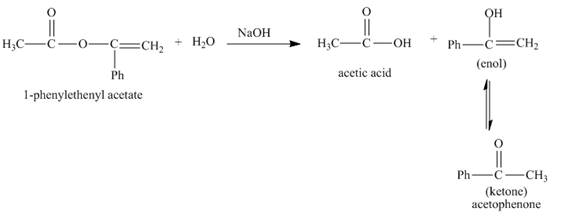
Explanation of Solution
The given incomplete reaction is shown below.

Figure 1
In the given reaction, the hydrolysis of ester takes place in the presence of base. The hydroxide ion of the sodium hydroxide reacts with the carbonyl carbon of the ester. The hysroxide group is a nucleophile which attacks at the electrophilic carbon. The hydrolysis of the ester gives acetic acid and enol. The enol tautomerises to form keto form. Both keto-enol co-exists in equilibrium. The complete reaction is shown below.
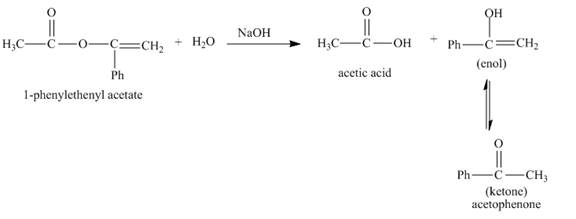
Figure 2
The complete given reaction with the products formed is shown in Figure 2.
(b)
Interpretation:
The given reaction is to be completed and product is to be shown.
Concept Introduction:
Trans esterification reaction is the reaction in which
Answer to Problem 21.54AP
The complete given reaction is shown below.
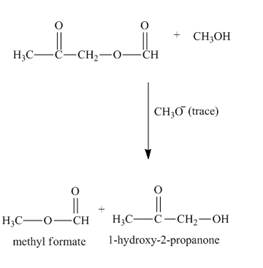
Explanation of Solution
The given incomplete reaction is shown below.

Figure 3
The
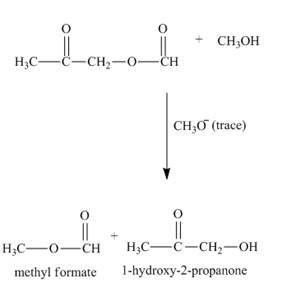
Figure 4
The complete reaction along with products formed is shown in Figure 4.
(c)
Interpretation:
The given reaction is to be completed and product is to be shown.
Concept Introduction:
Reaction of acid chloride with amine form amide compound. The phosgene reacts in similar way that of acid chloride with
Answer to Problem 21.54AP
The complete given reaction is shown below.

Explanation of Solution
The given incomplete reaction is shown below.

Figure 5
The lone pair of nitrogen of amine group attacks at the electrophilic carbonyl carbon of the phosgene. The chloride ion acts as leaving group and amide bond is formed. The amino group of

Figure 6
The complete reaction along with products formed is shown in Figure 6.
(d)
Interpretation:
The given reaction is to be completed and product is to be shown.
Concept Introduction:
Amide is formed in the reaction between acid chloride and amine. Hydrazine also reacts in same way. The hydrazine contains two amine groups, so it will reacts with the two equivalents of the acid chloride. Both the amine group of hydrazine gets acylated upon reaction with excess benzoyl chloride.
Answer to Problem 21.54AP
The complete given reaction is shown below.

Explanation of Solution
The given incomplete reaction is shown below.

Figure 7
The nitrogen atom of hydrazine acts as nucleophile and attacks at the carbonyl carbon of benzoyl chloride. It results in the formation of amide linkage. As, hydrazine posses two amine groups so the other amine group will also reacts with benzoyl chloride in the same way to form the desired product. The complete reaction is shown below.

Figure 8
The complete reaction along with products formed is shown in Figure 8.
(e)
Interpretation:
The given reaction is to be completed and product is to be shown.
Concept Introduction:
Amide group undergoes hydrolysis reaction in presence of an acid to form carboxylic acid and an amine. The nitrile group undergoes hydrolysis to form carboxylic acid and ammonia. The hydrolysis of nitrile takes place in strongly acidic medium.
Answer to Problem 21.54AP
The complete given reaction is shown below.

Explanation of Solution
The incomplete reaction is shown below.
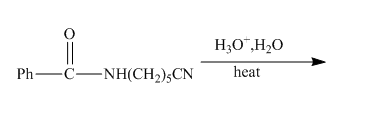
Figure 9
The hydrolysis of the amide bond takes place in acid or basic medium. The given compound in the presence of an acid will gert hydrolyzed. The hydrolysis of amide group forms amine and carboxylic acid. The hydrolysis of the nitrile group also takes place in strongly acidic medium to form carboxylic acid and ammonia. The given compound contains both amide and cyanide group, so both groups will get hydrolyzed. The resulting products will be acid, amino acid and ammonia. The complete reaction is shown below.

Figure 10
The complete reaction along with products formed is shown in Figure 10.
(f)
Interpretation:
The given reaction is to be completed and product is to be shown.
Concept Introduction:
Lactam is a cyclic amide compound. It will undergoes reduction reaction to form cyclic amine compounds. The reduction of lactam does not results in ring opening. Lithium aluminium hydride is used as the reducing agent. Imine intermediate is formed in the reduction of lactam.
Answer to Problem 21.54AP
The complete given reaction is shown below.

Explanation of Solution
The given incomplete reaction is shown below.
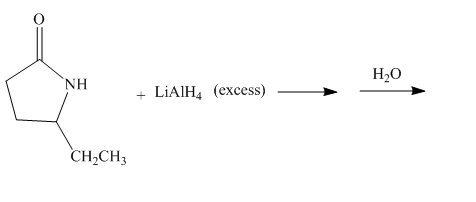
Figure 11
The lithium aluminium hydride is a strong reducing agent. It contains hydride ion which reacts with the carbonyl carbon. It will reduce the amide group to the amine group. The given compound is a lactam. The lactam will get reduced to cyclic amine. The reaction proceeds via cyclic imine intermediate. Cyclic imine intermediate is further reduced to the cyclic amine compound. The complete reaction is shown below.

Figure 12
The complete reaction along with products formed is shown in Figure 12.
(g)
Interpretation:
The given reaction is to be completed and product is to be shown.
Concept Introduction:
Grignard reagent reacts with esters to form tertiary alcohol. The reaction of lactone with grignard reagent also proceeds via same mechanism. The lactone is a cyclic ester compound. Lactone reacts with grignard reagent to form the dialcohol compound.
Answer to Problem 21.54AP
The complete given reaction is shown below.

Explanation of Solution
The given incomplete reaction is shown below.
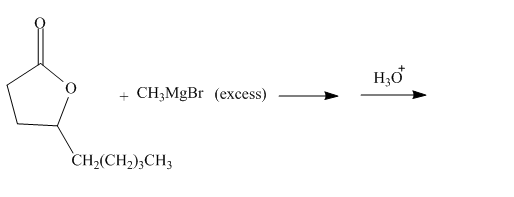
Figure 13
The carbonyl carbon of the lactone will undergo nucleophilic addition reaction with methyl magnesium bromide. The lactone will be coverted into the tertiary alcohol compound. Two equivalents of methyl magnesium bromide will react with the lactone to form the dialcohol product. The complete reaction is shown below.

Figure 14
The complete reaction along with products formed is shown in Figure 14.
(h)
Interpretation:
The given reaction is to be completed and product is to be shown.
Concept Introduction:
Grignard reagent reacts with esters to form tertiary alcohol. The reaction involves acyl substitution reaction which is followed by nucleophilic addition reaction. The reaction alkyl group of grignard reagent acts as the nucleophile and attacks at the carbonyl carbon of ester.
Answer to Problem 21.54AP
The complete given reaction is shown below.

Explanation of Solution
The given incomplete reaction is shown below.

Figure 15
The ethyl group of the ethyl magnesium bromide acts as nucleophile and attacks at the carbonyl carbon of the ester, which resuults in the formation of an ethyl ester with the removal of one

Figure 16
The complete reaction along with products formed is shown in Figure 16.
(i)
Interpretation:
The given reaction is to be completed and product is to be shown.
Concept Introduction:
Acid chloride reacts with lithium aluminium hydride to form alcohols. Lithium aluminium hydride is a strong reducing agent. The conversion of acid chloride into
Answer to Problem 21.54AP
The complete given reaction is shown below.

Explanation of Solution
The given incomplete reaction is shown below.

Figure 17

Figure 18
The complete reaction along with products formed is shown in Figure 18.
(j)
Interpretation:
The given reaction is to be completed and product is to be shown.
Concept Introduction:
Grignard reagent reacts with esters to form tertiary alcohol. The reaction involves acyl substitution reaction which is followed by nucleophilic addition reaction. The reaction alkyl group of grignard reagent acts as the nucleophile and attacks at the carbonyl carbon of ester.
Answer to Problem 21.54AP
The complete given reaction is shown below.

Explanation of Solution
The given incomplete reaction is shown below.

Figure 19
The given compound contains both the ester and aldehyde group. The grignard reagent reacts with both the groups, but if grignard reagent is taken in small amount then it will react with only the more reactive

Figure 20
The complete reaction along with products formed is shown in Figure 20.
(k)
Interpretation:
The given reaction is to be completed and product is to be shown.
Concept Introduction:
Trans esterification reaction is the reaction in which
Answer to Problem 21.54AP
The complete given reaction is shown below.
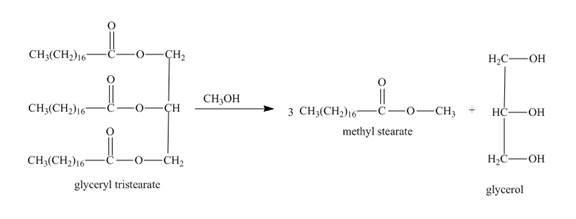
Explanation of Solution
The given incomplete reaction is shown below.

Figure 21
In this the glyceryl tristearate is a tri ester compound. In the presence of the methanol it will undergo transesterification reaction. The glyceryl tristearate reacts with methanol to form three equivalents of methyl stearate and one equivalent of glycerol. The complete reaction is shown below.

Figure 22
The complete reaction along with products formed is shown in Figure 22.
(l)
Interpretation:
The given reaction is to be completed and product is to be shown.
Concept Introduction:
Lactam are cyclic amide compound. It formed by the nucleophilic substitution reaction between the amine group and ester group present in the same molecule. Lactam undergoes reduction reaction to form cyclic amines. The nitrogen of amine group acts as nucleophilie and carbonyl carbon of ester acts as electriphilic centre.
Answer to Problem 21.54AP
The complete given reaction is shown below.

Explanation of Solution
The given incomplete reaction is shown below.

Figure 23
Esters on reaction with amine form amide compounds. As in the given compound the amine group and the ester group are present in the same molecule so upon reaction they will form cyclic amide compound known as lactam. The lone pair of nitogen atom attacks the carbonyl carbon of the ester to form the cyclic lactam with the elimination of alkoxy group. The complete reaction is shown below.

Figure 24
The complete reaction along with products formed is shown in Figure 24.
Want to see more full solutions like this?
Chapter 21 Solutions
ORGANIC CHEMISTRY SAPLING ACCESS + ETEX
- The electron of a hydrogen atom is excited to the 4d orbital. Calculate the energy of the emitted photon if the electron were to move to each of the following orbitals: (a) 1s; (b) 2p; (c) 2s; (d) 4s. (e) Suppose the outermost electron of a potassium atom were excited to a 4d orbital and then moved to each of these same orbitals. Describe qualitatively the differences that would be found between the emission spectra of potassium and hydrogen (do not perform calculations). Explain your answer.arrow_forwardImagine a four-dimensional world. In it, atoms would have one s orbital and four p orbitals in a given shell. (a) Describe the shape of the Periodic Table of the first 24 elements. (b) What elements would be the first two noble gases (use the names from our world that correspond to the atomic numbers).arrow_forwardThe electron affinity of thulium was measured by a technique called laser photodetachment electron spectroscopy. In this technique, a gaseous beam of anions of an element is bombarded with photons from a laser. The photons knock electrons off some of the anions, and the energies of the emitted electrons are detected. The incident radiation had a wavelength of 1064 nm, and the emitted electrons had an energy of 0.137 eV. Although the analysis is more complicated, we can obtain an estimate of the electron affinity from the energy difference between the photons and the emitted electrons. What is the electron affinity of thulium in electron volts and in kilojoules per mole?arrow_forward
- Be sure to answer all parts. The following alkyne is treated with 03 followed by H₂O. Part 1: How many different compounds are formed in this process? 1 Part 2 out of 2 Draw the product of the reaction. draw structure ...arrow_forwardMany fireworks use magnesium to burn, which releases a significant amount of energy. The heat released causes the oxide to glow, emitting white light. The color of this light can be changed by including nitrates and chlorides of elements that emit in the visible region of their spectra. One such compound is barium nitrate, which produces a yellow-green light. Excited barium ions generate light with wavelengths of 487 nm, 524 nm, 543 nm, and 578 nm. For each case, calculate: (a) the change in energy (in electron volts) of a barium atom and (b) the molar change in energy (in kilojoules per second).arrow_forwardClouds of hot, luminous interstellar hydrogen gas can be seen in some parts of the galaxy. In some hydrogen atoms, electrons are excited to quantum levels with n = 100 or higher. (a) Calculate the wavelength observed on Earth if the electrons fall from the level with n = 100 to one with n = 2. (b) In what series would this transition be found? (c) Some of these high-energy electrons fall into intermediate states, such as n = 90. Would the wavelengths of a transition from the state with n = 100 to one with n = 90 be longer or shorter than those in the Balmer series? Explain your answer.arrow_forward
- In the spectroscopic technique known as photoelectron spectroscopy (PES), ultraviolet radiation is directed at an atom or molecule. Electrons are ejected from the valence shell and their kinetic energies are measured. Since the energy of the incident ultraviolet photons is known and the kinetic energy of the ejected electron is measured, the ionization energy, I, can be deduced because total energy is conserved. (a) Show that the velocity, v, of the ejected electron and the frequency, n, of the incident radiation are related by hv = I + (1/2)mv^2? (b) Use this relation to calculate the ionization energy of a rubidium atom, knowing that light of wavelength 58.4 nm produces electrons with a velocity of 2,450 km/s Recall that 1 J = 1 kg.m^2/s^2arrow_forwardI) In Millikan's experiment, each droplet observed by the technicians contained an even number of electrons. If they had been unaware of this limitation, how would it have affected their report of an electron's charge?II) Millikan measured the charge of an electron in electrostatic units, esu. The data he collected included the following series of charges found on oil drops: 9.60 X 10^-10 esu, 1.92 X 10^-9 esu; 2.40 X 10^-9 esu; 2.88 X 10^-9 esu; and 4.80 X 10^-9 esu. (a) From this series, find the probable charge of the electron in electrostatic units. (b) Estimate the number of electrons in an oil drop with a charge of 6.72 X 10^-9 esu. The actual charge (in Coulombs) of an electron is 1.602 X 10^-19 C. What is the relationship between esu and Coulombs?arrow_forwardmy ccc edu - Search X Quick Access X D2L Homepage - Spring 2025 x N Netflix X Dimensional Analysis - A x+ pp.aktiv.com Q ☆ X Question 59 of 70 The volume of 1 unit of plasma is 200.0 mL If the recommended dosage for adult patients is 10.0 mL per kg of body mass, how many units are needed for a patient with a body mass of 80.0 kg ? 80.0 kg 10.0 DAL 1 units X X 4.00 units 1 1 Jeg 200.0 DAL L 1 units X 200.0 mL = 4.00 units ADD FACTOR *( ) DELETE ANSWER RESET D 200.0 2.00 1.60 × 10³ 80.0 4.00 0.0400 0.250 10.0 8.00 & mL mL/kg kg units/mL L unit Q Search delete prt sc 111 110 19arrow_forward
- Identify the starting material in the following reaction. Click the "draw structure" button to launch the drawing utility. draw structure ... [1] 0 3 C10H18 [2] CH3SCH3 Harrow_forwardIn an equilibrium mixture of the formation of ammonia from nitrogen and hydrogen, it is found that PNH3 = 0.147 atm, PN2 = 1.41 atm and Pн2 = 6.00 atm. Evaluate Kp and Kc at 500 °C. 2 NH3 (g) N2 (g) + 3 H₂ (g) K₂ = (PN2)(PH2)³ = (1.41) (6.00)³ = 1.41 x 104arrow_forwardWhat alkene or alkyne yields the following products after oxidative cleavage with ozone? Click the "draw structure" button to launch the drawing utility. and two equivalents of CH2=O draw structure ...arrow_forward
 ChemistryChemistryISBN:9781305957404Author:Steven S. Zumdahl, Susan A. Zumdahl, Donald J. DeCostePublisher:Cengage Learning
ChemistryChemistryISBN:9781305957404Author:Steven S. Zumdahl, Susan A. Zumdahl, Donald J. DeCostePublisher:Cengage Learning ChemistryChemistryISBN:9781259911156Author:Raymond Chang Dr., Jason Overby ProfessorPublisher:McGraw-Hill Education
ChemistryChemistryISBN:9781259911156Author:Raymond Chang Dr., Jason Overby ProfessorPublisher:McGraw-Hill Education Principles of Instrumental AnalysisChemistryISBN:9781305577213Author:Douglas A. Skoog, F. James Holler, Stanley R. CrouchPublisher:Cengage Learning
Principles of Instrumental AnalysisChemistryISBN:9781305577213Author:Douglas A. Skoog, F. James Holler, Stanley R. CrouchPublisher:Cengage Learning Organic ChemistryChemistryISBN:9780078021558Author:Janice Gorzynski Smith Dr.Publisher:McGraw-Hill Education
Organic ChemistryChemistryISBN:9780078021558Author:Janice Gorzynski Smith Dr.Publisher:McGraw-Hill Education Chemistry: Principles and ReactionsChemistryISBN:9781305079373Author:William L. Masterton, Cecile N. HurleyPublisher:Cengage Learning
Chemistry: Principles and ReactionsChemistryISBN:9781305079373Author:William L. Masterton, Cecile N. HurleyPublisher:Cengage Learning Elementary Principles of Chemical Processes, Bind...ChemistryISBN:9781118431221Author:Richard M. Felder, Ronald W. Rousseau, Lisa G. BullardPublisher:WILEY
Elementary Principles of Chemical Processes, Bind...ChemistryISBN:9781118431221Author:Richard M. Felder, Ronald W. Rousseau, Lisa G. BullardPublisher:WILEY





